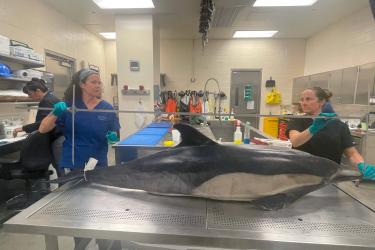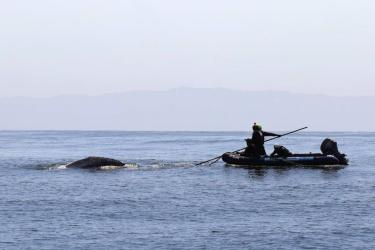As an undergraduate at the University of Washington majoring in Electrical Engineering, Abdi Omar hadn’t thought much about rockfish. He’d never even spent a day on a boat.
Omar works part time for the University of Washington’s Seattle Mathematics, Engineering, Science and Achievement (MESA) program. When he learned of a unique opportunity to partner with NOAA Fisheries and the Washington Department of Fish and Wildlife (WDFW) on a project studying rockfish, he jumped at the chance. Yelloweye rockfish are listed under the Endangered Species Act as threatened.
Seattle MESA has built a pathway to college and careers in science, technology, engineering, and mathematics. It provides students with innovative, hands-on opportunities in mathematics, basic and applied science, and engineering in both formal and informal settings. Recently MESA partnered with NOAA Fisheries and WDFW on a few science and outreach projects.
"This is a great opportunity for students to learn science by doing science in the field," said Nicolle HIll, Associate Deputy Regional Administrator for NOAA Fisheries' West Coast Region. "We all benefit from this kind of partnership—the students get experience, we get important species data, and we all get increasingly qualified students to draw from."
Omar recalled that he “used a program called 'Sebastes' to measure yelloweye rockfish that were documented on Remotely Operated Vehicles (ROV) surveys. By measuring how long individual fish are, you can understand how old they are and their reproductive potential.” Other surveys draw on the expertise of local anglers to assess the health of rockfish populations.
ROV Gathers Habitat, Species Data
An ROV is one of the best ways to document rockfish habitat use and population status, especially for deep-water species like yelloweye rockfish. In the past 10 years, numerous ROV surveys have been conducted by WDFW in partnership with NOAA Fisheries and Canada’s Department of Fisheries and Oceans (DFO). Typically, the ROV captures videos and stereo images along 30-minute transects along the seafloor. Once the survey is done, the videos and stereo images must be post-processed in order to identify, count, and measure observed fish.
“Omar was able to use the Sebastes program to obtain the first accurate length measurements of ESA-listed yelloweye rockfish, from transects completed during a recent survey with DFO in Canadian waters,” said WDFW Biologist Andrea Hennings. “He did a great job and was even able to join us for a day on an ROV survey in Puget Sound.”
The ROV survey and analysis will go a long way to providing important insights into the yelloweye rockfish population in the shared U.S. and Canada waters of the Georgia Strait. Yelloweye rockfish live more than 100 years in deep waters and are slow to reproduce.
Seattle MESA programs depend on voluntary participation of students throughout the Puget Sound area. Outreach in local schools is essential in sustaining student interest and participation in their programs and building positive relationships within targeted communities. In a recent partnership, NOAA Fisheries and WDFW scientists also worked with Seattle MESA and several University of Washington School of Aquatic and Fisheries Science (SAFS) students. They created an outreach activity featuring Puget Sound ROV surveys.
Activity and Lesson Plan for Local Students
For example, SAFS undergraduate Melinda Carr led development of the activity and lesson plan. The participating students will use tablets to view video footage from ROV surveys in Puget Sound and learn to identify fish and document marine habitats. Another objective is to help students understand how scientists estimate the size of fish populations to ensure fisheries remain sustainable.
Students will count fish from the videos and calculate the habitat and fish viewed by the ROV, using the data to estimate the size of the population. Graduate student Morgan Arrington said, “Contributing to the development of the rockfish and ROV lessons with MESA has been a highlight of my time at SAFS, and I know that the students who participate will be inspired to learn more about the unique species of fish in Puget Sound, and the innovative technology used to study them.”
The partnerships with MESA and the University of Washington are one of the ways NOAA Fisheries’ West Coast Region is advancing research and education. They also help our academic partners develop educational programs to improve diversity and retain traditionally underrepresented students in STEM fields.


